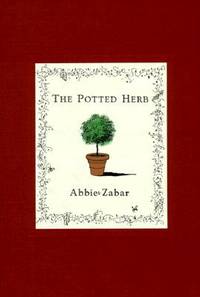
The Potted Herb
By Abbie Zabar, Author & Illustrator
1988
Review by Karen Smith
Abbie Zabar is the author of five books, as well as a graphic and garden designer, whose work has been displayed in the MOMA, the Louvre, Smithsonian Libraries, and other notable museums. She lives in New York City, where she savors the solitude of balcony gardening, which is why the book’s primary focus is on growing herbs in containers.
In the opening of the book, entitled “Herbal Beginnings,” the author gives a brief, but concise history of herbs dating back to Genesis. The use of herbs in food, festivals, rituals, and healing, was quite common throughout the ages. Neatly trimmed herbs were also used for monastery walls, hedges and fences. Garden beds were planted in an orderly design to avoid confusion when using herbs for medicinal purposes.
Various methods of plant propagation are suggested depending on the type of herb. Seed propagation is recommended for nonwoody producing herbs, such as basil, dill, and parsley. Root division is used for low-growing herbs like oregano, chives, tarragon, mint, marjoram and thyme. And layering should be used for sage, thyme, lavender, and other herbs with low flexible branches.
Terra cotta pots are the author’s personal choice for planting herbs, as they are “classically beautiful and functionally correct.” The clay pot “breathes” which keeps the soil from stagnating, and the simplicity of the material enhances the natural beauty of the plants. The author selected twenty-two herbs that would be suitable to grow in a pot. I particularly like how the history and folklore of each herb is discussed:
“It was said that a man who accepted a sprig of basil from a woman would love her forever, while a pot of basil on the balcony showed that a lady was welcoming her suitor’s advances.”
“Sprigs of oregano were put on graves in ancient Greece, and if they flowered the dead person was ensured a happy afterlife.”
Topiaries made from herbs were highly regarded by the author as they were “scaled-down” versions of gardens in the outside world. Detailed instructions are provided on how to create some basic designs, including the importance of careful pruning.
Herbal recipes include: Thyme-Flecked Black Olives, Cheese Bread with Six Bay Leaves, Sage Potato Crepes, Herb Cheese and Spinach Salad, Herbed Spiced Nuts and more. And if you have any herbs leftover, there are instructions for other uses, such as wreaths, sachet bags, incense, fragrant rubbing lotion and a herbal hand bath for gardeners’ hands.
The author concludes by reinforcing the notion that people can enjoy gardening on a small scale. “It will yield all of the same hopes, frustrations, and ultimate satisfactions for those who do their cultivating in a pot of terra cotta, rather than a plot of terra firma.”
